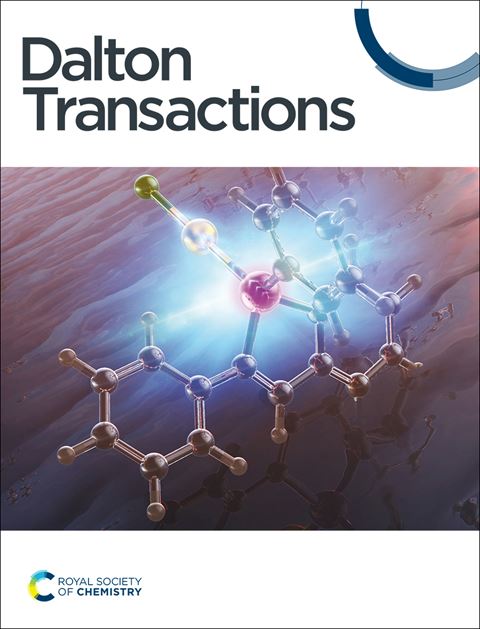Water Soluble Palladium Complexes Bearing NNN-Pincer Ligands: Synthesis, DFT Modeling, cT-DNA Interactions and In Vitro Cytotoxicity Studies Against Breast Cancer Cell Lines
IF 3.5
3区 化学
Q2 CHEMISTRY, INORGANIC & NUCLEAR
引用次数: 0
Abstract
In the pursuit of designing new anticancer pharmaceuticals and enhancing the therapeutic effectiveness of metal-containing compounds, two new Pd(II) pincer complexes, [Pd(o-LMe)Cl](OTf) (5) and [Pd(o-L′Me)Cl](OTf) (6), where o-LMe is (N2Z,N6Z)-N2,N6-bis(1-methylpyridin-2(1H)-ylidene)pyridine-2,6-dicarboxamide and o-L′Me is (N2Z,N6Z)-N2,N6-bis(1,4-dimethylpyridin-2(1H)-ylidene)pyridine-2,6-dicarboxamide commonly known as pyridylidene amide (PYA) ligands, were successfully synthesized and subjected to characterization through various spectroscopic methodologies. The PYA ligands were generated from proligands, o-H2LMe(OTf)2 (3) and o-H2L′Me(OTf)2 (4) during the complexation reaction. The precursors, 1 (o-H2L) and 2 (o-H2L′), were synthesized by treatment of dipicolinic acid with 2-aminopicoline and 2-amino-4-methylpicoline, respectively, in the presence of triphenyl phosphite followed by methylation to obtain o-H2LMe(OTf)2 (3) and o-H2L′Me(OTf)2 (4). The molecular structure of palladium complex (5)has been thoroughly analyzed through the SC-XRD, revealing a distorted square planar configuration encompassing two five-membered metallacyclic rings. The DFT approach meticulously investigated the electronic features, molecular electrostatic potential, and frontier molecular orbitals of the complexes. The nature of the compound’s interaction with cT-DNA and the implications of pincer-PYA coordination on the binding affinity of Pd(II) complexes were probed through UV-visible spectrophotometry and viscometry. The results elucidated the intercalative mode of interaction alongside elevated binding parameters for 5 (105 dm3/mol) and 6 (104 dm3/mol). Molecular docking of complex 5 was performed, which exhibited a strong interaction with DNA and supported the experimental findings. The in vitro cytotoxic effects of the samples were systematically assessed by MTT protocol on the breast cancer (MCF-7 and T47D) and normal (Vero) cell lines. According to the determined IC50 values, Pd(II) complexes demonstrated a prominent influence in augmenting cytotoxicity. The cytotoxicity values associated with these compounds follow a hierarchy of 5 > cisplatin > 6 > 4 > 3 within neoplastic cells. The apoptotic effects of 5 and 6 on the MCF-7 cancer cell line were examined to elucidate the mechanistic pathway responsible for its maximal cytotoxic efficacy.含nnn -钳形配体的水溶性钯配合物:合成、DFT建模、cT-DNA相互作用和对乳腺癌细胞系的体外细胞毒性研究
为了设计新的抗癌药物和提高含金属化合物的治疗效果,两种新的Pd(II)螯合物[Pd(o-LMe)Cl](OTf)(5)和[Pd(o-L 'Me)Cl](OTf)(6),其中o-LMe是(N2Z,N6Z)-N2, n6 -二(1-甲基吡啶-2(1H)-ylidene)吡啶-2,6-二羧酰胺,o-L 'Me是(N2Z,N6Z)-N2, n6 -二(1,4-二甲基吡啶-2(1H)-ylidene)吡啶-2,6-二羧酰胺,通常称为pyridylidene amide (PYA)配体。成功合成并通过各种光谱方法进行表征。PYA配体是由前配体o-H2LMe(OTf)2(3)和o-H2L 'Me (OTf)2(4)在络合反应中生成的。在亚磷酸三苯酯存在下,用2-氨基吡啶和2-氨基-4-甲基吡啶分别处理二吡啶酸,合成了前体1 (o-H2L)和2 (o-H2L’),然后甲基化得到o-H2LMe(OTf)2(3)和o-H2L’me (OTf)2(4)。通过SC-XRD对钯配合物(5)的分子结构进行了深入分析,发现其分子结构为扭曲的方形平面构型,包含两个五元金属环。DFT方法细致地研究了配合物的电子特征、分子静电势和前沿分子轨道。通过紫外可见分光光度法和粘度法研究了化合物与cT-DNA相互作用的性质,以及钳子- pya配位对Pd(II)配合物结合亲和力的影响。结果阐明了5 (105 dm3/mol)和6 (104 dm3/mol)的结合参数升高时相互作用的插入模式。配合物5的分子对接显示出与DNA的强相互作用,支持了实验结果。采用MTT方案系统地评估了样品对乳腺癌(MCF-7和T47D)和正常(Vero)细胞系的体外细胞毒作用。根据测定的IC50值,Pd(II)配合物在增强细胞毒性方面表现出显著的影响。与这些化合物相关的细胞毒性值遵循5 >;顺铂在6比;4比;3在肿瘤细胞内。研究了5和6对MCF-7癌细胞的凋亡作用,以阐明其最大细胞毒作用的机制途径。
本文章由计算机程序翻译,如有差异,请以英文原文为准。
求助全文
约1分钟内获得全文
求助全文
来源期刊

Dalton Transactions
化学-无机化学与核化学
CiteScore
6.60
自引率
7.50%
发文量
1832
审稿时长
1.5 months
期刊介绍:
Dalton Transactions is a journal for all areas of inorganic chemistry, which encompasses the organometallic, bioinorganic and materials chemistry of the elements, with applications including synthesis, catalysis, energy conversion/storage, electrical devices and medicine. Dalton Transactions welcomes high-quality, original submissions in all of these areas and more, where the advancement of knowledge in inorganic chemistry is significant.
 求助内容:
求助内容: 应助结果提醒方式:
应助结果提醒方式:


